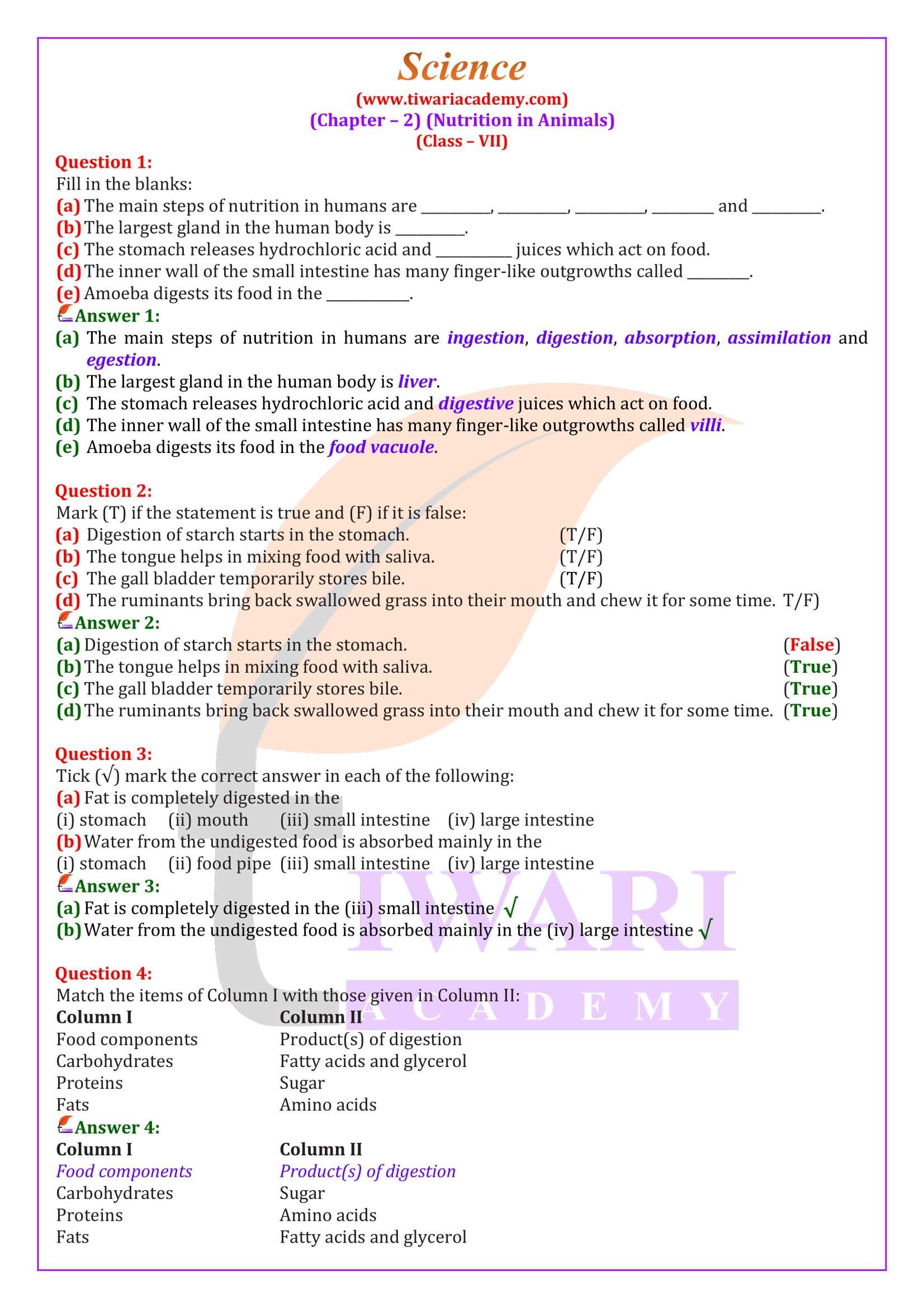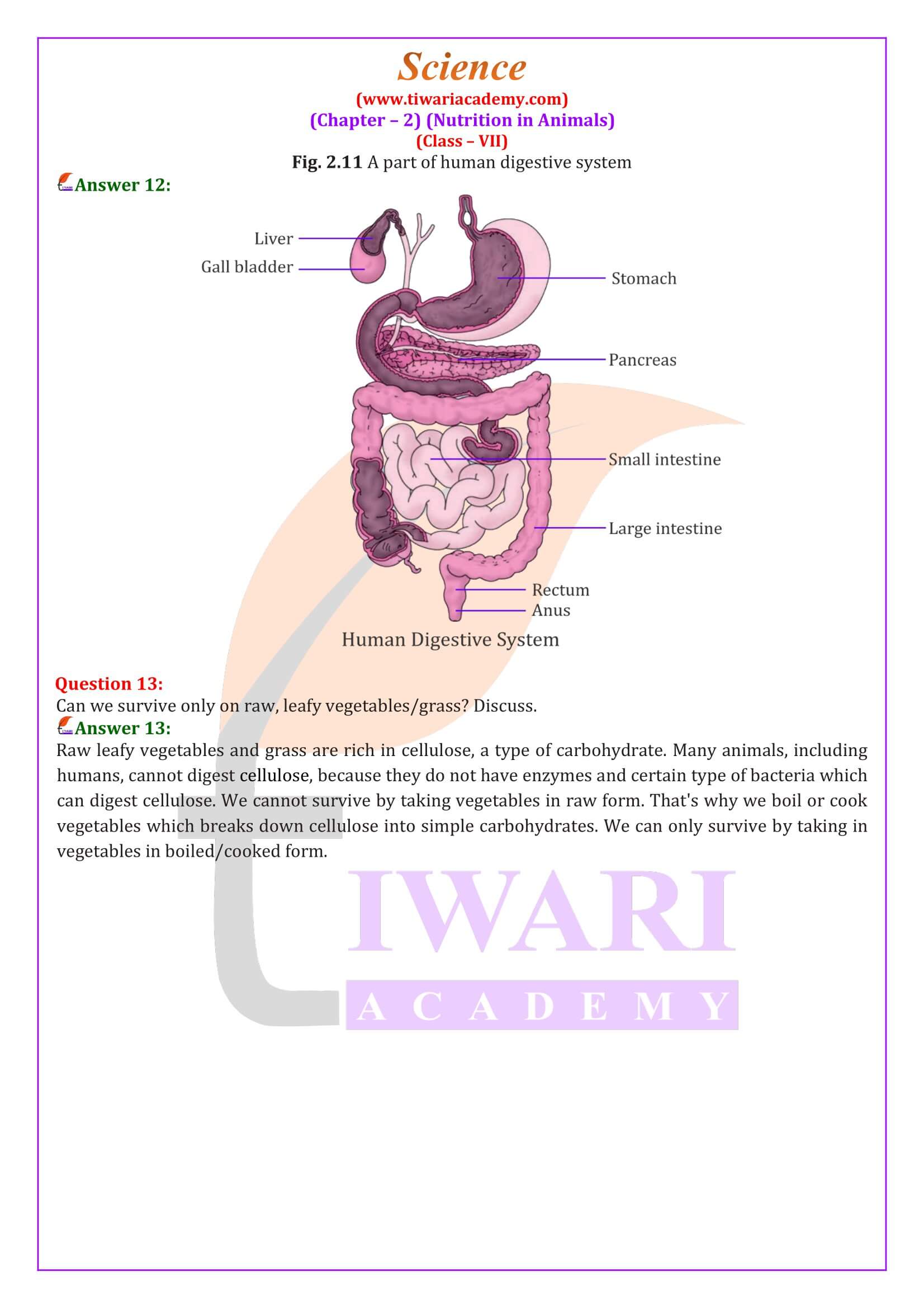Question Wise Class 7 Science Chapter 2 Solutions
Class 7 Science Chapter 2 NCERT Answers
Class 7 Science Chapter 2 in Hindi Medium
Class 7 Science Chapter 2 Extra Questions
Class 7 Science Chapter 2 MCQ Answers
Class 7 Science Book Download
NCERT Solutions for Class 7 Science
Class 7 all Subjects NCERT Solutions
NCERT Solutions for Class 7 Science Chapter 2 Nutrition in Animals in English and Hindi Medium free to download in PDF file or View online. Solutions are based on latest CBSE Text Books for the academic session 2024-25. Get here the revised solutions of 7th Science chapter 2 based on new textbooks published by NCERT for 2024-25 exams.
| Class: 7 | Science |
| Chapter 2: | Nutrition in Animals |
| Content: | Exercise Question Answers and MCQ |
| Academic Year: | Session 2024-25 |
| Medium: | English and Hindi Medium |
Class 7 Science Chapter 2 in English Medium
The explanation of Chapter 2 of 7th Science in video format is also given in English Medium and Hindi Medium separately. Through these videos all the keywords and important points are described, so that students can study more in less time. MCQ based on 7th Science Chapter 2 and important questions with intext questions and answers are good for terminal test as well as final school examination. Visit to discussion forum and ask Here questions and share with your friends. It is an open forum to discussion about question answers in any language. Download Offline apps based on latest CBSE Syllabus.
Class 7 Science Chapter 2 Explanation in Videos
Important Main Point in Class 7 Science Chapter 2
1. Different Ways of Taking Food
We have already studied about the nutrition in plants. This part of the content describes the nutritional needs and digestive system in human beings, along with other living beings. As we know that food is needed for every living organism. Plants can prepare their own food but animals cannot. But we know nutrition is required for every organism for energy. The food contains some nutrients like carbohydrate, protein, fat, vitamin and minerals which are required by our body for growth and development, called ‘Nutrition’.
Generally, in the process of nutrition, food is taken as a complex substance and break down in simpler substances, called ‘Digestion’. After that, it is utilised by our body. You may have observed that different types of animals show different modes of nutrition. Such as, eagle tear flesh of prey, hummingbirds suck the nectar from the flower, mosquito and lice suck blood from other organisms. And amoeba capture and swallow tiny aquatic animals, snake-like python swallow others animal on the whole, human and many other animals feed on mother’s milk.
2. Digestion in Human
In this part of the content gives sufficient idea about the journey of food in human beings. As you learnt before in the process of digestion, food is breakdown in simple substances and after it is utilised by our body. The journey of our food starts from the buccal cavity (mouth) then it moves on food pipe or oesophagus and after it reaches to the stomach, small intestine and next to the large intestine and last the anus. Remember, tooth and digestive glands play an important role in our digestion.
3. Process of Digestion
As you know, food is taken through the mouth with the help of teeth food is breakdown. You must know that our mouth has salivary glands. It secrets a juice, called saliva. We use our tongue for talking beside it mixes saliva with the food and helps in swallowing food. The swallowed food passes into the food pipe and reaches into the stomach. You know digestive juices and acids are present in the stomach which helps the food to digest due to some of the physical and chemical changes. Partially digested food reaches the small intestine where intestinal juices complete the digestion. You are surprised to know that our small intestine is 7.5 metres long and highly coiled. Similarly, our large intestine is about 1.5 metre-long, and it helps to remove waste material time-to-time through the anus.
4. Digestion in Grass Eating Animals
You may have observed that cows, buffaloes and other grass-eating animals chewing continuously, even when they are not eating. They quickly swallow the grass and store it in a part of a stomach, called ‘Rumen’. Hence, they are called ruminants. You may know that partially digested food or grass present in the rumen of a cow is called ‘Cud’. When this cud is thoroughly chewed in the mouth of the cow and swallowed again and reaches small intestine for complete digestion and absorption of food.
5. Feeding and Digestion in Amoeba
Have you ever seen amoeba? Your answer will be ‘no’. Do you know amoeba cannot see by naked eyes? Amoeba is single-celled microscopic organisms which are found in pond, lakes and other water sources. The body of amoeba has a finger-like projection called pseudopodia or false feet. It captures food and helps in locomotion of amoeba. Then the captured food break-down into simpler substances for digestion. This digested food is then absorbed and used for growth and maintenance by amoeba. In this way, you can see animals obtain their nutrients through a wide variety of feeding patterns. As nutrition is a must for a variety of reasons. Animals need the proper nutrition for growth, maintenance, transportation of materials and to provide energy for work and vital functions for their survival or existence.
Important Questions for 7th Science Chapter 2
1. The enzymes present in the saliva convert
(a) fats into fatty acids and glycerol.
(b) starch into simple sugars.
(c) proteins into amino acids.
(d) complex sugars into simple sugars.
2. Given below from (i) to (iv) are some food items.
(i) Boiled and mashed potato
(ii) Glucose solution
(iii) A slice of bread
(iv) Mustard oil
Which of the above will give blue-black colour when tested with iodine?
(a) (i) and (ii) (b) (i) and (iii) (c) (ii) and (iii) (d) (iii) and (iv)
3. Cud is the name given to the food of ruminants which is
(a) swallowed and undigested.
(b) swallowed and partially digested.
(c) properly chewed and partially digested.
(d) properly chewed and completely digested.
4. The acid present in the stomach
(a) kills the harmful bacteria that may enter along with the food.
(b) protects the stomach lining from harmful substances.
(c) digests starch into simpler sugars.
(d) makes the medium alkaline.
5. Which of the following pair of teeth differ in structure but are similar in function?
(a) canines and incisors.
(b) molars and premolars.
(c) incisors and molars.
(d) premolars and canines.
6. The finger-like outgrowths of Amoeba helps to ingest food. However, the finger-like outgrowths of human intestine helps to
(a) digest the fatty food substances.
(b) make the food soluble.
(c) absorb the digested food.
(d) absorb the undigested food.
7. Read carefully the terms given below. Which of the following set is the correct combination of organs that do not carry out any digestive functions?
(a) Oesophagus, Large Intestine, Rectum
(b) Buccal cavity, Oesophagus, Rectum
(c) Buccal cavity, Oesophagus, Large Intestine
(d) Small Intestine, Large Intestine, Rectum
8. Read the following statements with reference to the villi of small intestine.
(i) They have very thin walls.
(ii) They have a network of thin and small blood vessels close to the surface.
(iii) They have small pores through which food can easily pass.
(iv) They are finger-like projections.
Identify those statements which enable the villi to absorb digested food.
(a) (i), (ii) and (iv) (b) (ii), (iii) and (iv) (c) (iii) and (iv) (d) (i) and (iv)
9. The swallowed food moves downwards in the alimentary canal because of
(a) force provided by the muscular tongue.
(b) the flow of water taken with the food.
(c) gravitational pull.
(d) the contraction of muscles in the wall of food pipe.
10. The false feet of Amoeba are used for
(a) movement only.
(b) capture of food only.
(c) capture of food and movement.
(d) exchange of gases only.
Answers of Important MCQ
1 (b)
2 (b)
3 (b)
4 (a)
5 (b)
6 (c)
7 (a)
8 (a)
9 (d)
10 (c).
Important NCERT Questions Class 7 Science Chapter 2
What are villi? What is their location and function?
The inner walls of the small intestine have thousands of finger-like outgrowths. These are called villi (singular villus). The villi increase the surface area for absorption of the digested food. Each villus has a network of thin and small blood vessels close to its surface. The surface of the villi absorbs the digested food materials.
Where is the bile produced? Which component of the food does it help to digest?
Liver (the largest gland in human body) secretes bile juice that is stored in a sac called the gall bladder. The bile helps in the digestion of fats.
Why do we get instant energy from glucose?
In the cells, glucose breaks down with the help of oxygen into carbon dioxide and water, and energy is released.
Which part of the digestive canal is involved in absorption of food?
Small intestine.
Which part of the digestive canal is involved in killing of bacteria?
Stomach






